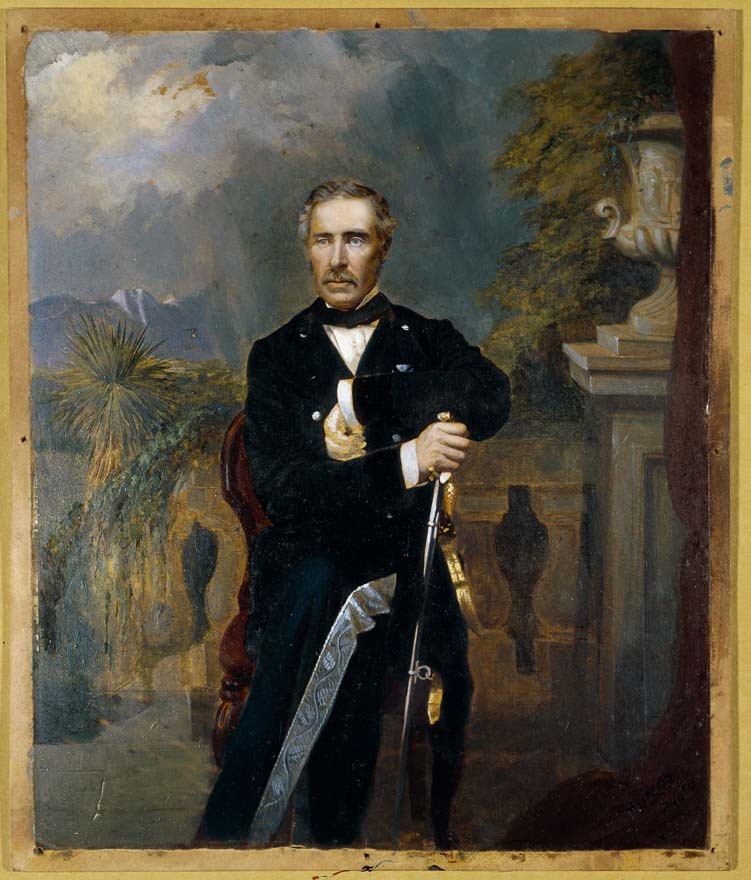
George Grey, painted by Daniel Mundy, circa 1860.
George Grey was arguably the most important figure in New Zealand’s post-1840 history. Born in 1812, he was trained in the military and served as a junior officer in Ireland, an experience which shaped his political views. After two ill-starred exploratory expeditions in western Australia between 1837 and 1839, Grey became deeply interested in the cultures of indigenous peoples. In 1840 he wrote a paper for the Colonial Office setting out his theories on racial assimilation. Impressed, his superiors made him governor of the struggling colony of South Australia. He succeeded in improving the financial position of the colony, but not its race relations.
In 1845 Grey was appointed governor of New Zealand, which faced similar difficulties to those he had confronted in South Australia. The colony was virtually bankrupt, and race relations were at a low point. But Grey was given the funds and the troops that had been denied his predecessor, Robert FitzRoy. And unlike FitzRoy, Grey was ruthlessly determined.
After the Northern War with Ngāpuhi chiefs Hōne Heke and Te Ruki Kawiti petered out, there was fighting in Hutt Valley, near Wellington. Ngāti Toa chief Te Rauparaha was kidnapped and imprisoned without charge or trial. Grey’s able lieutenant, Donald McLean, negotiated the purchase of large areas of fertile Māori land. As a result, European settlement grew rapidly. In 1848 Grey received a knighthood. He was the chief author of the 1852 constitution which set up provincial and national representative assemblies.
Grey left New Zealand in 1853 to become governor of Cape Colony, South Africa. In 1860 war broke out in Taranaki over the disputed Waitara purchase, and Grey was subsequently reappointed as governor of New Zealand. The hope was that through his mana and authority he could make peace. In 1861 he introduced a system of ‘new institutions’ – local tribal councils. Known as rūnanga, these would have some administrative and judicial functions. The aim was to avoid a repetition of the Waitara disaster, encourage further land sales, and create common ground between settler and Māori which would help racial assimilation. In this Grey largely failed. Fighting broke out again in Taranaki in 1863, partly because of his delay in returning Waitara to its owners.
After defeating the Taranaki ‘rebels’, Grey resolved to invade Waikato, the seat of the Kīngitanga (Māori King movement). It was also the main site of resistance to land sales and settler encroachment. Few historians now accept his justification for invasion, that the Waikato/Maniapoto tribes planned to attack Auckland. The Māori King and his followers were driven from their lands in Waikato after a series of hard-fought battles. In 1864 Grey and his ministers resolved to confiscate almost 3 million acres (1.2 million ha) from the ‘rebels’ in Waikato and elsewhere. Much of this land was set aside for military settlers or sold to pay for the costs of the war.
By 1865 the British imperial authorities were demanding that the settlers defend themselves and that British troops be withdrawn. Grey was reluctant to carry out these instructions. He was aware that the colony’s military forces were unprepared, and that there was a danger of further conflict. As a result, the British government terminated his appointment in 1868.
After a short period in England Grey retired to his New Zealand home on Kawau Island, where he continued the ethnographic research he had begun during his first term as governor. He later entered Parliament and became premier in 1877. In old age he returned to England, where he died in 1898.
If Grey had not taken up a second governorship in 1861, he would be remembered more affectionately. His reputation was tarnished by his policies in Taranaki, his invasion of Waikato, and the massive confiscation (raupatu) of Māori land which followed. The confiscations, in particular, caused decades of bitterness and deep division.

Community contributions